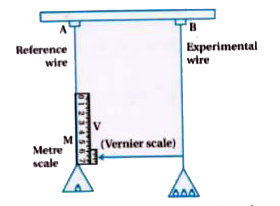Explain experimental determination of Young's modulus. Solution in Gujrati
A typical experimental arrangment to determine Young.s modulus of a material of wire is shown as in figure.

It consists of two long straight wires of same length and equal radius suspended side by side from a fixed rigid support.
The wire A (reference wire) carries a millimeter main scale M and a pan to place a weight. The wire B (experimental wire) of uniform area of cross-section also carries a pan in which known weights can be placed
A vernier scale V is attached to a pointer at the bottom of the experimental wire B and the main scale M is fixed to the reference wire A. The weights placed in the pan exert a downward force and stretch the experimental wire under a tensile stress. The elongation of the wire is measured by the vernier arrangement.
The reference wire is used to compensate for any change in length that may occur due to change in room temperature, any change ir length of the reference wire will be accompanied by an equal change in experimental wire.
Both the reference and experimental wires are given an initial small load to keep the wires straight and the vernier reading is noted.
Now the experimental wire is gradually loaded with more weights to bring it under a tensile stress and the vernier reading is noted again.
The difference between two vernier readings gives the elongation produced in the wire.
Let r and L be the initial radius and length of the experimental wire respectively then the area of cross-section of wire would be πr2 Let M be the mass that produced an elongation ΔL in the wire, thus the applied force is equal to Mg where g is the acceleration due to gravity
The Young.s modulus of the material of wire,
Y=σε=F/AΔL/L=FLAΔL
=Mgπr2=LΔL
Y=MgLπr2ΔL
Y can be determined by putting each of known velues in above equation.
Topper's Solved these Questions
- BOOK - KUMAR PRAKASHANCHAPTER - MACHANICAL PROPERTIES OF SOLIDS EXERCISE - SECTION-A TRY YOURSELF (VSQs)40videos
MACHANICAL PROPERTIES OF SOLIDS
- BOOK - KUMAR PRAKASHANCHAPTER - MACHANICAL PROPERTIES OF SOLIDS EXERCISE - SECTION-B45videos
MACHANICAL PROPERTIES OF SOLIDS
- BOOK - KUMAR PRAKASHANCHAPTER - LAW OF MOTIONEXERCISE - (QUESTION PAPER) SECTION-D1videos
LAW OF MOTION
- BOOK - KUMAR PRAKASHANCHAPTER - MECHANICAL PROPERTIES OF FLUIDS EXERCISE - QUESTION PAPER (SECTION -C)3videos
MECHANICAL PROPERTIES OF FLUIDS
Similar Questions
What are solid bodies composed ?
04:01View SolutionA structural steel rod has a radius of 10 mm and a length of 1.0 m. A 100 KN force stretches it along its length. Calculate a stress, (b) elongation and (c) strain on the rod. Young's modulus of structural steel is2.0×1011Nm−2.
View SolutionA 70 kg man stands in contact against the inner wall of a hollow cylindrical drum of radius 3 m rotating about its vertical axis with 200 rev/min. The coefficient of friction between the wall and his clothing is 0.15. What is the minimum rotational speed of the cylinder to enable the man to remain stuck to the wall (without falling) when the floor is suddenly removed ?
03:05View SolutionGlycerine flows steadily through a horizontal tube of length 1.5m and radius 1.0 cm . If the amount of glycerine collected per second at one is 4.0×10−3kgs−1 , what is the pressure difference between the two ends of the tube ? (Density of glycerine =1.3×10103kgm−3 and viscosity of glycerine =0.83 Pa s). [ you may also like to check if the assumption of laminar flow in the tube is correct]
03:50View SolutionDiscuss experimental determination of Young's modulus of a metallic wire.
01:35View SolutionDescribe a method to determine Young's modulus of the material of a thin wire.
11:38View SolutionThe Young's modulus, bulk modulus and the modulus of rigidity have
07:12View SolutionTo determine Young's modulus of the material of a wire,
10:31View SolutionIn an experiment to determine the Young's modulus of the material of a wire, the length of the wire and the suspended mass are doubled. Then the Young's modulus of the wire
01:44View SolutionExplain the Young's double slit experimental setup and obtain the equation for path difference.
11:38View SolutionExplain the experimental determination of material of the prism using spectrometer. Determination of angle of the prism.
02:13View SolutionDefine Young's modulus, Bulk modulus and Shear modulus.
03:00View SolutionIn Youngs double slit experiment, to increase the fringe width
02:37View SolutionExplain the Young's double slit experimental setup and obtain the equation for path difference.
05:20View SolutionWhat is Young's modulus ? Explain.
03:05View Solution
